
Are you planning a stay in Lyon to explore its traditional way of life, sample its gastronomic delights in a traditional Bouchon, visit its many museums, and discover its culture, heritage and association with the silk trade?
Located 320 km north of Marseille and 470 km south-east of Paris, Lyon is considered by many to be the culinary capital of France.
The third largest city in France, Lyon was founded in 43BC by the Roman legions, and subsequently became the capital city of the Gauls.
With nearly five million visitors a year, it is one of France’s most visited cities and draws visitors from around the world.
In this blog, to help you plan your stay, I have highlighted eight of the best areas in Lyon to book lodgings.
I have also noted some of the best attractions in each area, where you can enjoy the various architectural styles, traditional cuisine, historical monuments, interesting museums and the captivating atmosphere of this ancient and modern metropolis.
Where to stay in Lyon: 8 best areas
1. Presqu´ile, where to stay in Lyon for first-timers
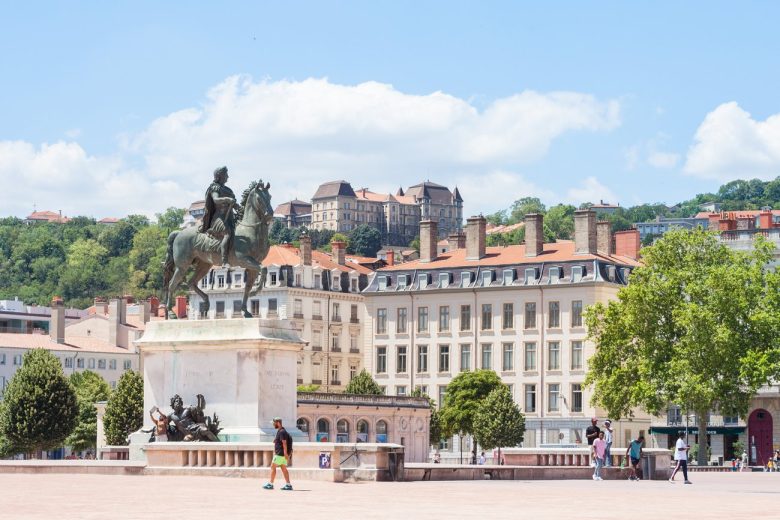
Lyon sits on the converging point of the rivers Rhône and Saône, and the district of Presqu’ile is located on the peninsula between the two rivers. It is joined to both areas by numerous bridges and subways.
Considered the city centre of Lyon, Presqu’ile has a history dating back to the Middle Ages, when a small settlement was founded to take advantage of the nearby waterways.
In 1998, along with around 10% of Lyon’s other iconic areas, Presqu’ile was designated a UNESCO World Heritage Site.
The large main square (Place Bellecour) is the beating heart of Presqu’ile and is highlighted by the tall plinth and sculpture of Louis XIV on horseback. It is the favoured meeting place for social get-togethers, political and other gatherings, concerts, and numerous festivals.
It is also home to the Big Wheel, where you can book a ride and enjoy rooftop views across the city.
Presqu’ile also has its fair share of impressive 19th-century buildings around the Place des Terreaux, including the majestic City Hall (Hôtel de Ville).
For the shoppers amongst us, the Rue de la Republique is the main shopping street in the city and has retail establishments from fashionable boutiques to designer-label outlets and everything in between branching off on its boulevards and avenues.
With its many cafes and restaurants, a pleasant morning or afternoon can be spent enjoying a little window shopping and soaking up the atmosphere with some light refreshments.
All around the area are cobbled courtyards and quaint narrow streets where you will find modern boutiques, local and international restaurants, coffee shops and bistros.
You can also visit impressive churches such as the Église St-Nizier.
Place Bellecour is where you’ll find the Tourist Information Office and at the northern end of the square, you come to Croix-Rousse. The area was once home to many silk producers and weavers in the 19th century and now houses a variety of retail businesses.
Other places of interest around Presqu’ile include The Museum of Fine Arts, the National Opera and the Théatre des Célstins.
Riverboat trips are also available from the quay at the Quai des Célestins.
Although the whole of Lyon has excellent public transport infrastructure, there’s nothing like strolling the streets and alleyways to get a real feel of local culture and lifestyle. And Presqu’ile is the ideal place to start.
For your stay in Lyon, business and leisure accommodations around Presqu’ile are plentiful and range from basic hostels and apartments to economical two- and three-star lodgings to five-star luxury hotels.
BEST PLACES TO STAY IN PRESQU´ILE
- ($$$) InterContinental Lyon – Hotel Dieu, an IHG Hotel
- ($$) Hotel Carlton Lyon – MGallery Hotel Collection
- ($) Lyo Hôtel – Centre Lyon Perrache
2. Vieux Lyon, great place to stay in Lyon for couples
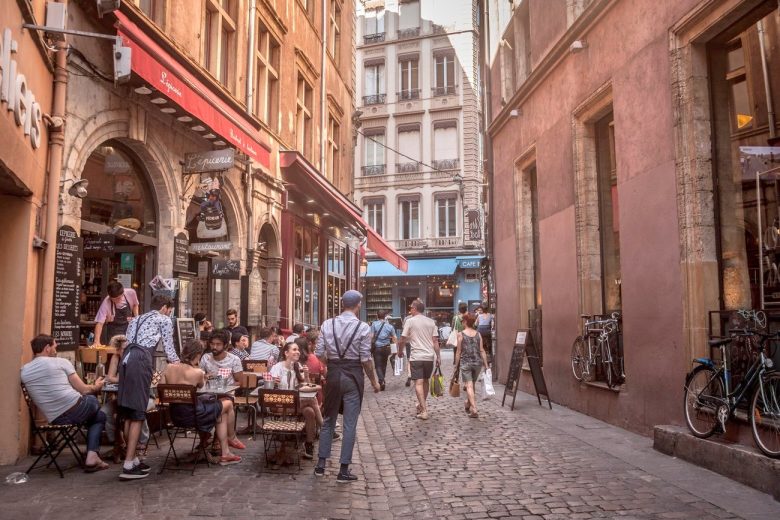
Considered the Old Town area of Lyon, Vieux Lyon nestles at the bottom of Fourviére Hill, on the quayside of the River Saône opposite Presque’lle, and is a mix of colourful Renaissance, Gothic and Romanesque architecture.
It is a district that thrived during the 15th and 16th centuries, as trade between Spain, Italy, Holland and France began to increase with new businesses and an increasing population.
Vieux Lyon is made up of three main quarters. Saint Georges sits to the south, Saint-Paul to the north and Saint-Jean in the centre.
There are over 20 excellent attractions you can visit in Vieux Lyon, as well as gourmet food tours and boat trips. The following are just a few to show you what’s available.
- Musée Miniature et Cinéma: A museum highlighting Lyon’s association with cinema and the puppet world.
- The Basilica of Notre-Dame de Fourvière: An interesting basilica overlooking Lyon and built between 1872 and 1896.
- The Cathédrale Saint-Jean-Baptiste: One of Lyon’s most magnificent buildings. Construction began in 1180 and wasn’t completed until 1476.
- Musée des Arts de la Marionnette: Another puppet museum that the kids will love.
- Musée d’Histoire de Lyon: Learn about the history of Lyon and its relationship to the puppet world.
- Jardin des Curiosités: Enjoy an alfresco picnic in this 6000 sqm park with some stunning birds-eye views of the town below and the Alps and Mont Blanc in the distance.
- Fourvière funicular: There are two funiculars to enjoy in Lyon, and both start at Vieux Lyon. The first takes you to the Lugdunum Roman remains. The second to the top of Fourviere Hill and the gates of the basilica.
When the time comes to seek out those gifts for friends and family back home, look for the Rue du Boeuf or the Rue Saint-Jean.
These streets are the one-time centre of Lyon’s silk industry, and today, there are numerous artisan shops where you can find handmade silk scarves, other silk apparel, and all kinds of unique souvenirs.
With its cobbled streets and squares, hidden passageways built through buildings (traboules), Cathedral Saint-Jean-Baptiste, museums, chocolate, ice cream and crepe cafes, wine bars, craft workshops and fine-dining restaurants, it is a delight to explore day and night, and an excellent area in Lyon to base yourself.
Vieux Lyon is a great place for couples and families to stay in Lyon. It is probably the most romantic neighbourhood in Lyon.
BEST PLACES TO STAY IN VIEUX LYON
3. Lyon-Fourviere, well located for sightseeing
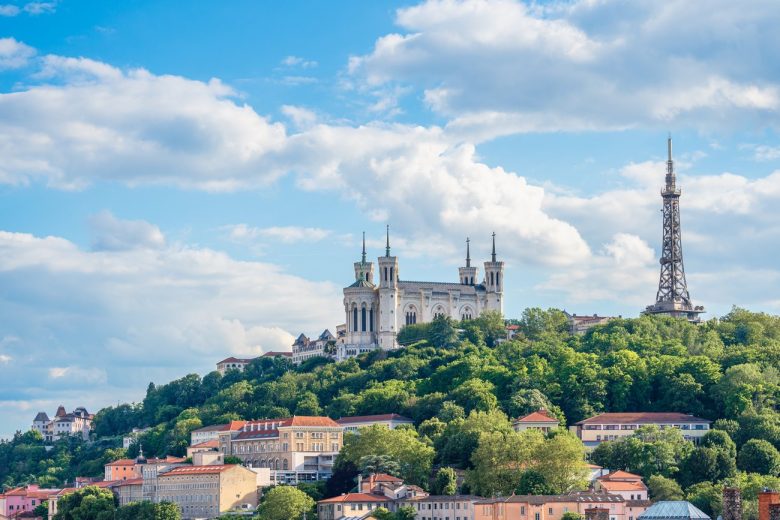
The Lyon skyline is dominated by Fourviere Hill and its look-alike mini Eiffel Tower. Now a communications tower called La Tour Metallique, it sits majestically 372 metres above sea level and is the City of Lyon’s highest point.
Fourviere Hill, awarded UNESCO World Heritage status in 1998, has been one of Lyon’s most popular tourist attractions for decades.
Over two million visitors, many of them pilgrims, arrive to tour the ornate Basilique Notre de Fourviere (circa 1896) and other churches, the Roman ruins, museums and surrounding attractions.
Fourviere has been a popular, if somewhat tired residential area for years, but since the early 2000s, the whole district has had a facelift. New hotels, bouchons, cafes, restaurants, and shops have opened, old walking and hiking paths have been refurbished, and signage has been improved.
The hill’s summit is split into three main sections: Saint-Irénée, Saint-Just and Fourvière. Each offers a different perspective of the surrounding areas.
Whether you choose Fourviere for your stay in Lyon or just wish to explore this intriguing area in Lyon, there are two ways to get there – by foot or by funicular.
Walking is popular with many guests, and the main routes to get to the top are the Rue du Chemin Neuf through the Rosaire Gardens to the basilica, or the steps at Nicolas de Lange to the rear of Gare Saint-Paul.
The less strenuous choice is to ride the funicular, which begins its journey from Vieux Lyon old town, and takes just a few minutes to reach the summit.
There are two funiculars in operation. One terminates at the basilica, and the other at the Roman ruins. Both offer excellent photographic opportunities across the Lyon skyline.
Accommodations at Fourviere is very limited and comprise some hotels and Airbnbs.
BEST PLACES TO STAY IN LYON IN FOURVIERE
- ($$$) Villa Maïa
- ($$) Fourvière Hôtel
- ($$) Le Jardin de Beauvoir
4. The Confluence District, cool neighborhood
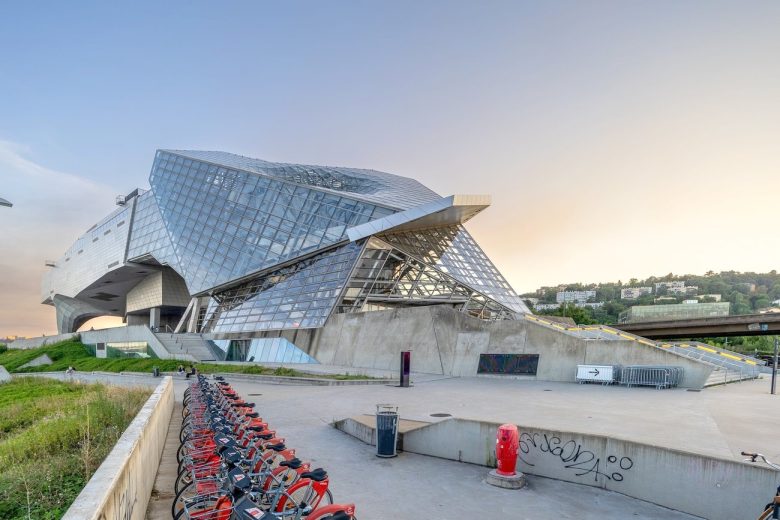
Situated on the riverbanks just south of Presque’lle, this one-time derelict industrial park of over 140 hectares, renamed the Confluence district, is today a futuristic neighbourhood of eco-friendly hotels, green open spaces, cutting edge architecture, retail establishments, cafes, bars, clubs and restaurants.
Work began in 2000 with a budget that ran into millions of euros. The remit was to produce a futuristic, eco-friendly and sustainable retail, business, leisure and residential district.
Two buildings worth a mention are:
- The Pôle de Commerces et de Loisirs Confluence shopping mall: which has a completely transparent roof that allows natural light to flood the complex.
The shopping mall is more than just a shopping mall. It also includes restaurants, cafes, a cinema, fashion boutiques, arcade games, and climbing frames to keep the youngsters happy.
- The Museum of Science and Humanities (Musée des Confluences): Situated at the confluence of the rivers Rhône and Saône, the futuristic building is constructed almost entirely of glass and steel.
Besides the nearby rivers (where you can book river cruises), the close-by Parc de Saône has over 10 hectares of lakes and ponds and over 3,000 species of trees where you can enjoy picnics, sports, photography or just a pleasant stroll or cycle.
Accommodation in confluence for your stay in Lyon ranges from apartments, Airbnb, comfortable boutique hotels and villas.
BEST PLACES TO STAY IN THE CONFLUENCE DISTRICT
- ($$) Novotel Lyon Centre-Confluence Bord de Saone
- ($$) Keystone Hôtel & Spa
- ($) ibis budget Lyon Centre Confluence
5. Part Dieu, modern and business area

Sitting on the left bank of the River Rhône, Part-Dieu is a business, retail, and residential area.
Established in the 14th century, in the 18th century, the area was farmed by a local landowner, providing fresh produce for the Lyon population.
In 1850, the land was sold to the French army and converted to barracks. It stayed that way into the 20th century, until 1960, when Lyon City Council bought it for development into a prestigious multi-purpose business and leisure facility.
The project was also designed to improve transport connections to the city centre and beyond. To this end, the Part-Dieu railway station, complete with an underground shopping arcade, opened for business in 1980.
The station services the high-speed Rhône Express and local suburban lines, as well as the Metro, buses, trams and taxis.
The Part-Dieu shopping complex, one of the largest in Europe, has undergone several facelifts and extensions since its inception in the 1960s. Today, it hosts over 240 retail establishments, a cinema, cafes, and restaurants.
One of the complex’s most stand-out pieces of modern architecture is the Tour Part-Dieu. Constructed in 1976, it is 164 metres high and known locally as The Pencil (or Crayon) due to its shape. Close by is the InCity office block, standing 200 metres high.
If you fancy a bite to eat while exploring Part-Dieu, the Lyon’s Halles Paul Bocuse Food Hall comes highly recommended.
Other places of interest include:
- The Auditorium concert hall
- The Bourse du Travail theatre
- Government and Council buildings
- And the Municipal Library
For that much-needed downtime, there are numerous cafes and bars with terraces and patios where you can indulge in a little people-watching. You will also find plenty of rooftop bars and restaurants with a view.
Or you can chill, and enjoy strolling in the parks, gardens and riverside walks.
BEST PLACES TO STAY IN PART DIEU
- ($$$) Pullman Lyon
- ($$) Hôtel Le Roosevelt Lyon
- ($) Slo Lyon Saxe
6. Croix-Rousse, where to stay in Lyon for local vibes
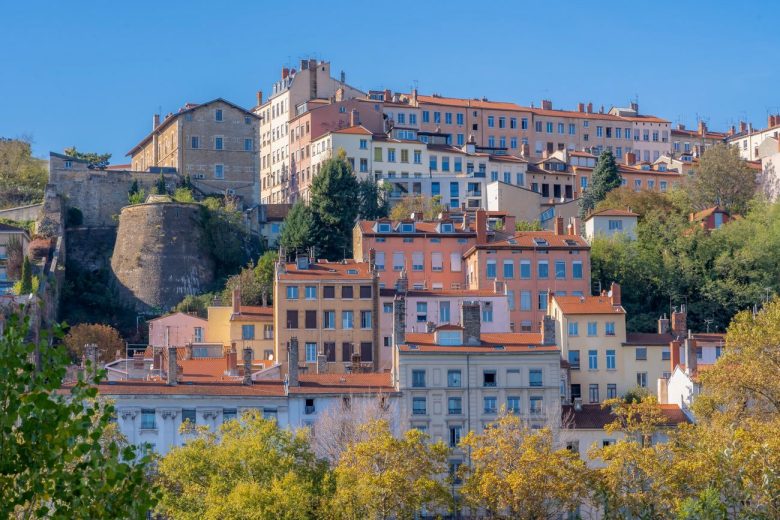
The historic district of La Croix-Rousse is located between the rivers Saône and Rhône on a 254-metre high hill of the same name, and is a part of the UNESCO Heritage Site.
Lyon’s association with silk began way back in the 16th century, when the Canut (silk weavers) set up silk-weaving businesses in Saint-Georges in Vieux-Lyon.
However, it was in the 18th century, when the Canut weavers began to move into updated apartments on the slopes and summit of La Croix-Rousse, that silk production became a significant part of Lyon’s economy.
To help the large number of weavers moving to the area, apartments were adapted with high, four or five-metre ceilings to accommodate the looms. And extra large windows to allow maximum light into the work area.
As more Canut moved to the area and business increased, Croix-Rousse became known locally as ‘the working hill’.
Eventually, in the mid-20th century, as the silk industry began to decline, the whole district fell into a state of disrepair.
This, however, didn’t last long, and by the 1970s/80s, the area underwent a major facelift. It began attracting Lyon’s young, affluent singles and families. A new, youthful vibe was born that today reverberates around the district in its village-style shopping areas, bars, cafes and restaurants.
Much of La Croix-Rousse’s historic past remains in its narrow, cobbled streets, squares, apartments and traditional traboules joining one building to another.
Even so, modern, independent businesses, including handmade and retro fashion boutiques, jewellery and accessory shops, delicatessens, art galleries, artisan workshops, cafes and organic eateries, can be found around the district.
Places of particular interest include:
- The Fresque des Lyonnais. An amazing mural depicting Lyon’s most famous citizens, and takes up two sides of a one-time, bare, insignificant warehouse building
- The local village square
- The Amphitheatre of the Three Gaules (take the steps from the square)
- The Museum of the Maison des Canut
- The secret garden of Rosa Mir
For your stay in Lyon, with its excellent views across the city, Pentes de La Croix-Rousse is an ideal location with a good selection of accommodations from B&Bs, Airbnb, and apartments to high-end hotels.
BEST PLACES TO STAY IN CROIX-ROUSSE
- ($$$) Hôtel Fort St Laurent Lyon – Handwritten Collection
- ($$) TRIBE Lyon Croix Rousse
- ($) Ibis Styles Lyon Croix Rousse
7. Guillotière and Gerland, where to stay in Lyon on a budget
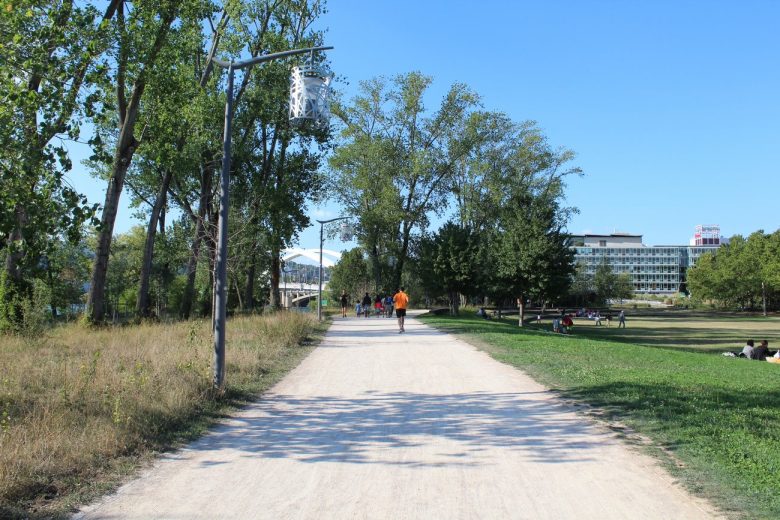
The districts of Guillotiere and Garland share a common border and in many other ways, they couldn’t be farther apart.
Guillotière
In the 1800s, La Guillotière was the only place in Lyon where you could cross the Rhône River, making it very busy with traders, commuters and immigrants.
La Guillotière is one of the biggest multicultural districts in Lyon and a melting pot of European, African, Asian and Arab nationalities. Emigrants have been arriving in the district for almost as long as it has been established.
Roots were put down generations ago, and you will find a thriving Chinatown area and international eateries from around the world.
With lodgings generally cheaper than in the town centres, it is also a popular district with young backpackers and college students, giving many of the traditional Bouchons, bars and cafes a pleasant, trendy, young vibe.
Street art is also becoming popular in La Guillotière, and some interesting creations can be found as you stroll through the neighbourhood.
Gerland
Sitting on the bank of the Rhône River in the 7th arrondissement, Gerland takes its name from Castle Gerland, which stood in the area in the early 19th century.
At one time a purely industrial site, it fell under the authority of Lyon’s administrative council in 1852. Although a certain amount of urbanisation was undertaken in the early 20th century, it wasn’t until 1972 that the first homes were built in Gerland.
Since the 1980s, the district has continued to evolve, with new schools, green open spaces, hotels, shops, businesses and supporting infrastructure. It is also home to some of France’s major biotechnology and pharmaceutical industries and commercial research laboratories.
Today, Gerland is a bustling commercial/residential district popular with visitors due to its excellent connections to other areas of Lyon via the Metro, trams, and numerous bus routes.
Places of interest include the Halle Tony Garnier. It was originally built in 1905 as a slaughterhouse and used until 1967, when it closed down.
In 1975, it was declared a historic monument, and in 1987 was transformed into a 17,000-seat stadium for international pop and rock concerts and other festivities.
Gerland is well served with retail outlets, bars and restaurants, and a couple to look out for when the hunger pangs kick in are: La Commune food hall, over a dozen start-up cafés and restaurants under one roof, where you can enjoy lunch or dinner. And La Maison, a large bar/restaurant ideal for family outings or corporate events.
Generally cheaper than the city centre and old town areas for your stay in Lyon, you can choose from a selection of apartments, Airbnb, villas and hotels.
BEST PLACES TO STAY IN GUILLOTIERE AND GARLAND
8. The Airport Area, cheaper hotels
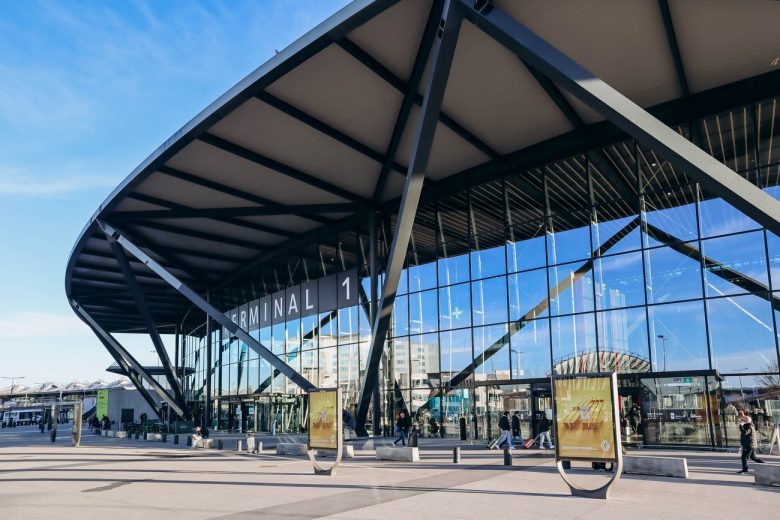
In today’s fast-moving business world with increasingly tight schedules, globe-trotting business executives invariably take advantage of airport hotels for their 24-hour or 36-hour stopovers.
But what about our leisure travellers, those on a short city break or a week’s holiday? Would staying in the airport area in Lyon be beneficial?
Lyon Saint-Exupéry Airport lies 25 kilometres outside Lyon, in the Rhône department of the Auvergne-Rhône-Alpes, and is surrounded by scenic countryside, fields and vineyards.
There are a lot of hotels dotted around the airport district, with half a dozen within a kilometre of the airport boundaries and one in the airport terminal.
Although Lyon Airport is well served by public transport, trains, trams, bus routes and taxis, many hotels offer complimentary shuttles, while others charge a small fee for airport collections and drop-offs.
Some airport hotels also provide a drop-off/pick-up service for hotel guests wanting to visit different areas in Lyon.
For those planning to hire a car for their stay in Lyon, airport hotels can also offer some big positives over city-centre lodgings.
Hotel parking is invariably available at airport hotels, while with the city’s higher density of buildings and population, not necessarily so. This means that in the city, you probably need to start factoring in overnight parking costs.
Also, for those days you plan to visit districts outside the centre, an airport hotel means you can bypass the hustle and bustle of city streets in your hire car, and head straight to your chosen destination.
Finally, add to that the generally cheaper cost of airport hotels on a like-for-like basis, and there’s a lot to be said for considering airport hotels for your stay in Lyon.
BEST PLACES TO STAY IN THE AIRPORT AREA